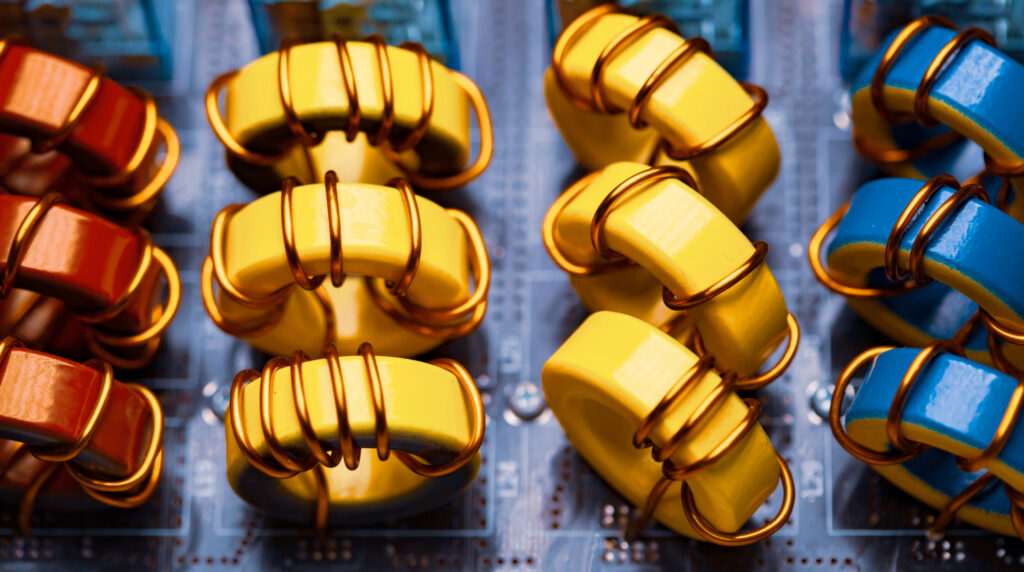Inductors & Coils
Inductors & Coils: Function and Applications in Electronic Circuits
Inductors, also known as coils or chokes, are passive electronic components that store energy in a magnetic field when current flows through them. They play a vital role in various electronic circuits by controlling current, storing energy, and affecting the behavior of signals. This article provides an overview of inductors, explaining how they function and their applications in electronic circuits.
- How Inductors Function
An inductor consists of a coil of wire wound around a core, typically made of ferromagnetic material. When an electric current passes through the coil, a magnetic field is generated around it. The magnetic field stores energy, which can be released when the current changes. Inductors resist changes in current, causing a delay in response to voltage changes, as the magnetic field opposes the flow of current. This property is known as inductance and is measured in henries (H). - Applications of Inductors
a) Filtering: Inductors are used in combination with capacitors to form filters that allow certain frequencies to pass while attenuating others. They are commonly employed in power supplies and audio circuits to remove unwanted noise or ripple from DC signals.
b) Energy Storage: Inductors store energy in their magnetic fields and can release it when the current changes. This property is utilized in applications such as boost converters, flyback transformers, and energy storage devices.
c) Oscillators and Timing Circuits: Inductors, along with capacitors, are essential components in oscillators and timing circuits. They control the oscillation frequency and timing intervals, enabling precise timing and signal generation.
d) Transformers: Inductors are key components in transformers, which transfer electrical energy between different voltage levels. Transformers find extensive use in power distribution systems, voltage conversion, and isolation of circuits.
e) Inductive Loads: Inductive loads, such as motors, solenoids, and relays, rely on the magnetic fields generated by inductors. Inductors help control the current and protect circuits from voltage spikes when these loads are switched on or off.
f) RF Applications: Inductors are crucial in radio frequency (RF) circuits, serving as components in filters, impedance matching networks, and resonant circuits. They are used in wireless communication devices, antennas, and RF amplifiers.
g) Signal Coupling: Inductors are employed for coupling or linking different stages of a circuit, allowing the transfer of AC signals while blocking DC components. This enables signal transmission and amplification in audio circuits, amplifiers, and data communication systems.
h) Sensor Applications: Inductive sensors, such as proximity sensors and inductive position sensors, utilize changes in inductance to detect the presence or position of objects. They find applications in automation, robotics, and industrial control systems.
- Inductor Construction
Inductors are constructed by winding insulated wire around a core. The core material can be air, iron, ferrite, or other magnetic materials. The number of wire turns and the core material impact the inductance value and the overall performance of the inductor. Inductors can be surface-mounted or through-hole components, depending on the circuit’s requirements. - Inductor Characteristics
Apart from inductance, inductors have other characteristics that affect their performance in circuits:
a) Saturation Current: The maximum current that an inductor can handle without its inductance significantly reducing.
b) Q-Factor: The quality factor represents the efficiency of an inductor, indicating how well it stores and releases energy. A higher Q-factor indicates less energy loss and better performance.
c) Self-Resonant Frequency: Inductors have a self-resonant frequency
Inductors, with their ability to store energy in a magnetic field and control current, are indispensable components in electronic circuits. Their applications span across a wide range of fields, including power electronics, signal processing, communications, and sensing. By understanding the function and applications of inductors, engineers and designers can harness their unique properties to achieve desired circuit behaviors.
Whether it is filtering unwanted noise, transforming voltage levels, generating precise timing signals, coupling signals between circuit stages, or detecting the presence of objects, inductors play a vital role in numerous electronic devices and systems. From power supplies to audio amplifiers, from RF circuits to motor control, inductors provide crucial functionality and enable efficient and reliable operation.
The selection of the appropriate inductor, considering factors such as inductance value, saturation current, Q-factor, and self-resonant frequency, is crucial in designing circuits that meet specific requirements. The construction and materials of inductors also impact their performance and suitability for different applications.
As technology continues to advance, the demand for smaller, more efficient, and higher-performing inductors grows. Innovation in inductor design, including the development of integrated inductors and miniaturized components, enables the realization of compact and high-performance electronic devices.
In conclusion, the importance of inductors in electronic circuits cannot be overstated. Their ability to store and control energy, along with their versatility in various applications, makes them essential components in modern electronic systems. By leveraging the unique properties of inductors, engineers can design circuits with improved efficiency, stability, and functionality, contributing to the advancement of technology in numerous industries.

